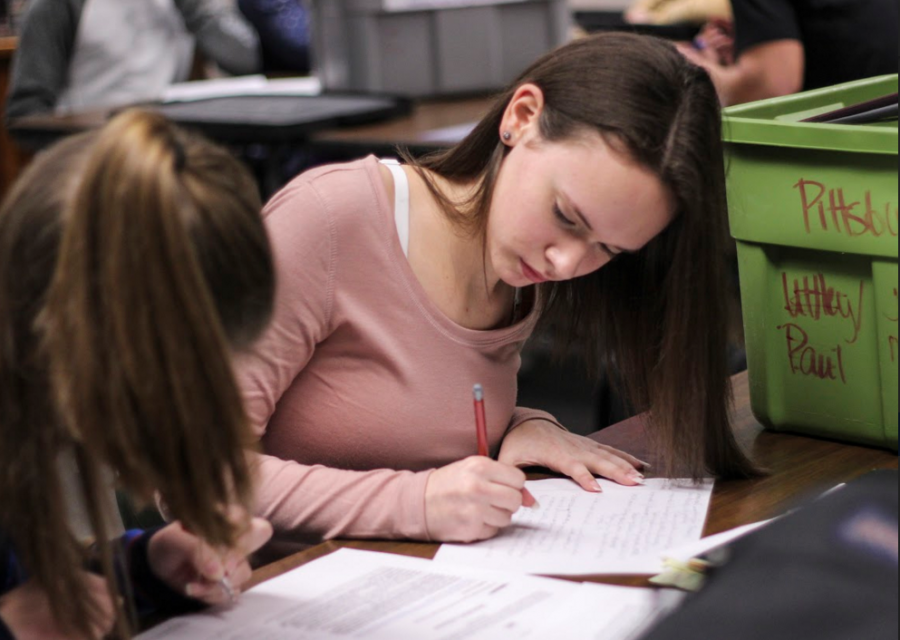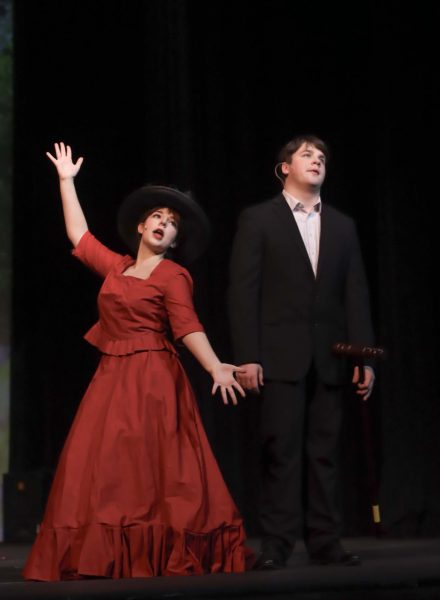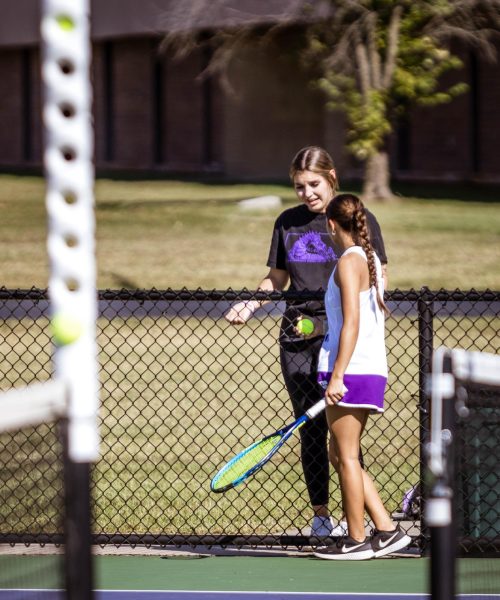Mastering the art of a strong rebuttal
Coach, debaters weigh in on how to argue effectively
Photo by: Morgan Noe
As a new member of debate, freshman Jessica Neef in enjoying the class. “It is really hard, but it is also really fun,” Neef said. “I like researching, creating cases and searching through new evidence.” Neef wrote a paper preparing her for her debate.
As he stands at the podium, legal pad and pen in hand, junior Austin Edwards prepares to deliver an eight-minute speech about education reform.
This year, policy debaters argue the national topic: “The United States federal government should substantially increase its funding and/or regulation of elementary and/or secondary education in the United States.”
Preparing stances for and against the resolution, debaters research topics like computer education, charter schools and standardized testing.
However in recent years, society has seen the principles of debate decline.
“Whenever people feel really strongly about something, they are emotionally charged one way or the other,” speech and debate coach Julie Laflen said. “The problem is we’re not listening to what the other person is saying. All we can think about is how we disagree and we can’t wait [until] we get to offer our opinion next. In the debate world, you have to listen [and] look at the evidence read in the round to need to show why [it is] more superior.”
Many in the debate community agree that argumentation in the real world is ineffective.
“When the presidential debates [were] going on, there [were] so many open-ended claims being debated that [weren’t] really valid,” junior Haley Garzone said. “In policy debate rounds, it’s quite professional, but in the real world, it gets pretty heated.”
As hashtags and trending topics dominate newsfeeds, more users are engaging in controversial conversation.
Consequently, teenagers use social platforms as forums to voice their opinions. At such a divisive time, arguing has emboldened many to speak out, but often ineffectively.
The Booster asked debaters how they argue effectively in and out of the classroom.
The format of policy debate consists of four eight-minute constructive speeches, intended to construct or build up a team’s arguments. Then, each debater presents a five-minute rebuttal focusing on their winning arguments.
“In the rebuttal, you look at all the things that have been said in the entire debate round and narrow down the biggest points to be made,” Laflen said. “Usually, this is very subjective because you may think something is way more important than your opponent or judge may think, so you have to be really strategic.”
For students who want to voice their opinions, debaters advise them to be well-versed on their topic.
“Research is really important, but also having a basis for your argument,” Garzone said. “You have to have evidence to back up what you’re saying, but you also have to be very knowledgeable about what you’re talking about. In a rebuttal, that’s what can win rounds.”
By addressing the opposing stance, debaters are far more likely to stay on topic and appeal to judges.
“A lot of people don’t like to acknowledge the other side,” sophomore Jordan Akins said. “What you have to do is take a look at the other perspective and research their side. See what they’re saying and why they believe that. Then, you can go ahead and counterclaim that.”
Clash is an element of debate that promotes argumentation based directly on another’s arguments.
“Clash is essentially this idea that you have two competing [arguments] going against one another,” junior Austin Edwards said. “They either contradict or can’t happen at the same time, so you have to weigh the options and pick whichever [argument] would be comparatively advantageous.”
The significance of the rebuttal stems from summarizing key points in the round and comparing them through clash.
“Clash and rebuttals are closely tied together,” junior Nathan Newby said. “Clash is killed if you don’t use your rebuttals properly and [argue] what’s important in the round.”
The structure of policy debate does not permit emotional arguments. In forensics, students can practice Lincoln-Douglas debate, modeled after the senate debates between Abraham Lincoln and Stephen Douglas that focused on undermining the other’s argument based on morals and values.
Edwards strongly advises against this method in policy debate.
“We don’t use ad hominem attacks,” Edwards said. “Once you start focusing on the person making the argument and not the argument itself, that’s how you know you either lost the argument or missed the point to begin with.”
Laflen fosters these skills in her class by rehearsing speech drills, cross-examining the opposition and analyzing evidence.
“We [practice] so many skills at once, we don’t even realize what we’re doing,” Laflen said. “Debate isn’t just about arguing; that is such a small part of what we do. It’s about being able to think on your toes, listen to something and question its validity. I just love watching [debaters] use those skills and not even realize that they’re doing them. I’m truly hoping those skills overflow into other aspects of these kids’ lives.”
Your donation will support the student journalists of Pittsburg High School - KS. Your contribution will allow us to purchase equipment and cover our annual website hosting costs.










